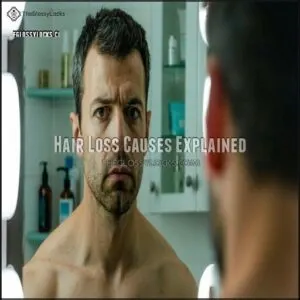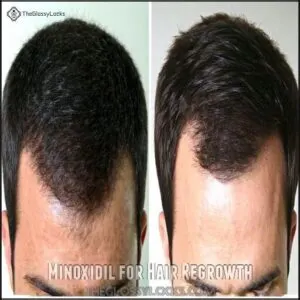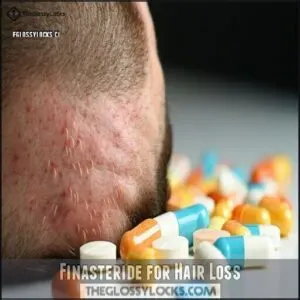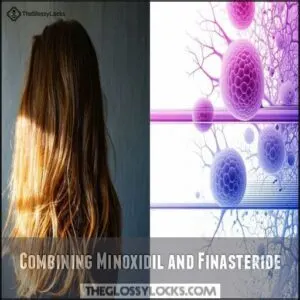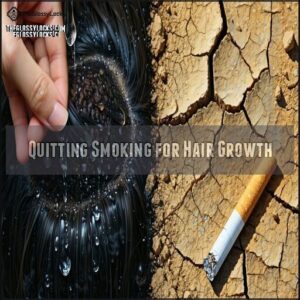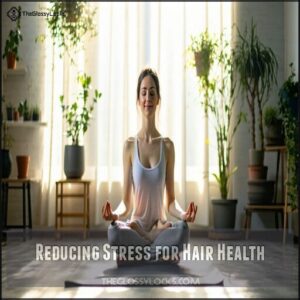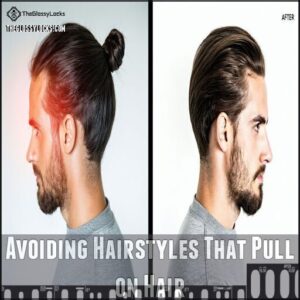This site is supported by our readers. We may earn a commission, at no cost to you, if you purchase through links.
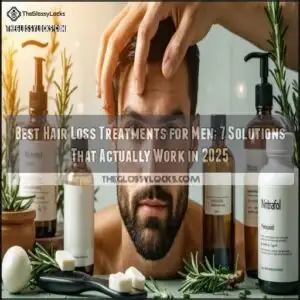 Finding the best hair loss treatments for men doesn’t have to feel like searching for a needle in a haystack.
Finding the best hair loss treatments for men doesn’t have to feel like searching for a needle in a haystack.
Proven solutions like Minoxidil (Rogaine) and Finasteride (Propecia) are top picks for tackling male pattern baldness.
Minoxidil stimulates hair growth directly, while Finasteride blocks DHT, a hormone linked to hair loss.
If you’re into gadgets, FDA-cleared laser caps or combs can boost growth too.
Supplements like Nutrafol or using rosemary oil can support healthier, thicker hair over time.
Throw in a stress-free lifestyle, a balanced diet, and you’re giving your scalp its best shot.
Curious about what works best together? Keep reading!
Table Of Contents
- Key Takeaways
- Hair Loss Causes Explained
- Effective Hair Loss Treatments
- Top 7 Hair Loss Treatments
- 1. Rogaine 5 Minoxidil Hair Regrowth Foam
- 2. Laser Hair Growth System FDA Cleared
- 3. Hims Hair Regrowth Foam 5 Minoxidil
- 4. Nutrafol Mens Hair Growth Supplement
- 5. Mens Rogaine Extra Strength Hair Regrowth Treatment
- 6. Rogaine Womens 5 Minoxidil Foam Hair Regrowth
- 7. Hims Extra Strength Minoxidil Hair Regrowth Foam
- Lifestyle Changes for Hair Growth
- Natural Remedies for Hair Regrowth
- Frequently Asked Questions (FAQs)
- What are the most effective treatments for men’s hair loss?
- Can a man’s hair grow back?
- Can hair grow back after thinning?
- What is the best treatment for male hair loss?
- What promotes hair loss in men?
- What is the best treatment for hair loss in men?
- What is the most effective hair loss product for men?
- What is the best treatment for hair loss?
- What is the best hair loss treatment for men in 2024?
- Can you actually stop male hair loss?
- Conclusion
Key Takeaways
- Combine FDA-approved treatments like minoxidil and finasteride for the best results; minoxidil boosts blood flow to the scalp, while finasteride blocks DHT, the hormone responsible for hair loss.
- Consistency is key—use treatments daily and give them at least 3-6 months to show noticeable improvements.
- Natural remedies like rosemary oil and supplements like Nutrafol can support healthier, thicker hair alongside other treatments.
- Make lifestyle changes such as quitting smoking, managing stress, and eating a balanced diet to promote long-term hair growth and prevent further thinning.
Hair Loss Causes Explained
Your hair loss stems from various factors including genetics, hormones, and lifestyle choices that affect how your hair follicles function.
Genetics, hormones, and lifestyle all influence your hair follicles—understanding these factors is the key to choosing effective treatments.
Understanding these causes helps you choose the right treatment option, whether it’s medication like finasteride, or topical solutions like minoxidil.
Lifestyle changes that can slow or reverse your hair thinning are also an option, and should be considered as part of your overall treatment plan.
Male Pattern Hair Loss
Male pattern baldness is the most common cause of hair loss in men.
It’s driven by DHT sensitivity and genetic predisposition, affecting up to 70% of men during their lifetime.
You’ll notice a receding hairline and crown thinning as distinctive signs.
While you can’t change your genetics, various hair loss treatments like minoxidil for men and DHT blockers can help when you maintain proper treatment adherence.
Telogen Effluvium
Unlike male pattern baldness, telogen effluvium (TE) happens when your hair’s growth cycle gets disrupted, pushing too many hairs into the shedding phase at once.
Telogen effluvium occurs when a disrupted growth cycle sends hair into a shedding spree, but it’s often temporary with the right care.
You’ll notice widespread thinning rather than patches. TE triggers include illness, surgery, medications, or extreme stress.
The good news? This type of hair loss is usually temporary, lasting 3-6 months if you address the underlying cause. A potential factor to keep in mind is nutrient deficiencies that can exacerbate hair shedding.
Alopecia Areata
Three distinct forms of autoimmune alopecia affect about 7 million Americans.
Your immune system attacks hair follicles, causing patchy hair loss in random areas.
Emerging therapies like JAK inhibitors now offer hope for this condition that affects men of all ages.
- Living with alopecia areata can cause significant emotional impact
- Childhood alopecia cases require special consideration due to psychological effects
- Various alopecia subtypes respond differently to treatment options, from mild to severe cases, which is why emerging therapies and understanding the condition are crucial for effective management and support, including the use of autoimmune alopecia treatments.
Effective Hair Loss Treatments
You’ll find real solutions for hair loss that have been clinically proven to work, including FDA-approved medications and advanced procedures that target the root causes.
These treatments can help you maintain your existing hair and stimulate new growth when used consistently, giving you back the confidence that comes with a fuller head of hair.
Minoxidil for Hair Regrowth
Now that you understand what causes your hair loss, let’s look at one effective solution.
Minoxidil is the first FDA-approved topical treatment for hair regrowth.
You’ll need to apply it twice daily and stick with it—results typically take 2-4 months to appear.
Many users find success with consistent product application.
| Aspect | Details | What to Expect |
|---|---|---|
| Concentration | 5% solution most effective | Better results than lower strengths |
| Application | 1ml solution or half-capful foam | Apply to dry/damp scalp |
| Duration | 4 months minimum | Continued use necessary |
| Results | 14-18% more hair after 1 year | Peak effects at 1 year |
| Side Effects | Initial shedding possible | Typically temporary |
The key to success with Minoxidil is consistent application and patience, as it may take several months to see noticeable hair regrowth.
It’s essential to follow the instructions carefully and be aware of the potential side effects, which can include initial shedding, but are typically temporary.
Finasteride for Hair Loss
While minoxidil works directly on your scalp, finasteride targets the hormonal cause of male pattern hair loss.
This prescription medication blocks DHT, the hormone responsible for shrinking hair follicles.
Finasteride’s proven track record includes:
- Stopping further hair loss in 83% of men after 2 years
- Requiring only a 1mg daily dosage
- Showing visible results within 3-6 months
- Working best when started early
- Requiring continuous use (results disappear within a year after stopping)
Many users explore options for purchasing finasteride products, and it is essential to understand that continuous use is necessary for maintaining the desired effects.
Combining Minoxidil and Finasteride
Working together like a dynamic duo, Finasteride and Minoxidil create powerful synergistic effects for male pattern hair loss treatment.
Recent 2025 research confirms this combination delivers superior results compared to either medication alone.
Combining these medications offers a dual-action approach for enhanced hair growth.
| Treatment Strategy | Mechanism | Treatment Efficacy | Side Effects |
|---|---|---|---|
| Finasteride | Blocks DHT | 80.5% success | Sexual function concerns |
| Minoxidil | Boosts blood flow | 59% success | Scalp irritation |
| Combination | Dual-action approach | 94.1% success | Manageable with proper dosage strategies |
| Long-Term Use | Maintenance therapy | Sustained results | Typically decrease over time |
The table above shows the treatment efficacy for Finasteride, Minoxidil, and their combination, highlighting the superior results of the combination therapy, with a success rate of 94.1%.
Top 7 Hair Loss Treatments
You’ll find these seven scientifically-backed treatments offer real hope for your thinning hair, with options ranging from FDA-approved medications to cutting-edge laser systems.
Each solution targets the biological mechanisms of hair loss differently, allowing you to choose what works best for your specific needs and lifestyle, offering a sense of control over your hair loss.
1. Rogaine 5 Minoxidil Hair Regrowth Foam
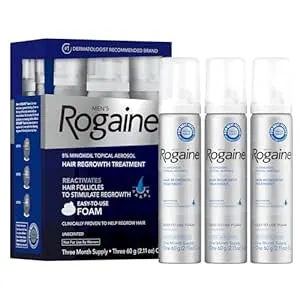
At the forefront of hair loss solutions stands Rogaine 5% Minoxidil Foam, the first FDA-approved topical treatment proven to regrow hair.
This three-bottle supply works by reviving shrinking follicles and extending your hair’s natural growth cycle. The innovative Tricho-Prime technology conditions your scalp while preventing irritation.
You’ll need to apply half a capful twice daily and commit to at least four months for noticeable results. While some users experience temporary shedding initially, consistent application typically leads to thicker, fuller hair.
Remember, continued use is necessary to maintain your regrowth results and ensure that the treatment’s benefits are long-lasting with consistent application.
Best For: Men experiencing hereditary hair loss who are committed to a consistent routine for long-term hair regrowth.
- Requires a minimum 4-month commitment for noticeable results.
- Temporary shedding phase can be concerning for some users.
- Continued use is necessary to sustain hair regrowth.
- Clinically proven to regrow hair and improve thickness with 5% Minoxidil.
- Easy-to-apply foam fits conveniently into daily routines.
- Tricho-Prime technology conditions the scalp and prevents irritation.
2. Laser Hair Growth System FDA Cleared
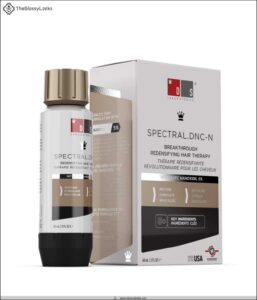
Looking to tackle hair loss without drugs?
Laser hair growth systems offer an FDA-cleared alternative that’s gaining popularity.
These devices use low-level laser therapy to stimulate follicles and improve circulation.
The iRestore system has helped over 500,000 customers with visible results in just 3 months.
Similarly, Hairmax devices boast a 93% success rate.
Most systems feature auto shut-off functions and wireless operation for convenience.
While upfront costs are higher than topical treatments, they’re non-invasive and generally side-effect free.
For best results, consistent use is essential.
Best For: Individuals seeking a non-invasive, drug-free solution to combat hair loss and promote natural hair regrowth.
- Higher upfront cost compared to topical treatments.
- Mixed effectiveness when compared to prescription solutions.
- Delivery and packaging issues reported by some users.
- FDA-cleared devices offering safe and effective hair loss treatment.
- Non-invasive and generally free from side effects.
- Visible results reported within 2-3 months of consistent use.
3. Hims Hair Regrowth Foam 5 Minoxidil
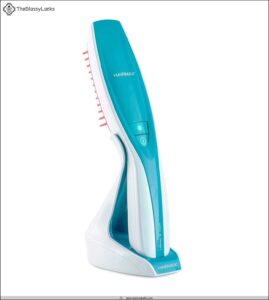
Hims offers a powerful 5% minoxidil foam that’s clinically proven to regrow hair within 3-6 months.
This FDA-approved solution specifically targets your thinning areas, reactivating dormant follicles on the top of your head.
You’ll notice hair that’s not just returning, but looking thicker and fuller with consistent use.
The foam format makes application clean and straightforward—simply use twice daily for best results.
At $19/month, it’s an affordable option compared to pricier treatments.
Many users report seeing significant improvements after the 3-month mark with this convenient, effective solution.
Best For: Individuals experiencing thinning hair who want a clinically proven, affordable, and easy-to-use treatment option.
- Requires consistent use twice daily for results.
- Visible effects may take up to 3-6 months.
- Only targets hair loss on the crown, not broader areas.
- Clinically proven to regrow hair in 3-6 months.
- Affordable at $19/month compared to other treatments.
- Easy foam application for clean and straightforward use.
4. Nutrafol Mens Hair Growth Supplement
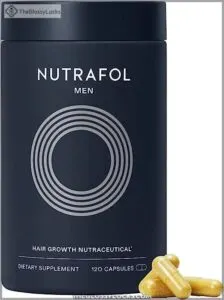
Nutrafol Men’s Hair Growth Supplement tackles hair loss at its roots with a blend of 21 natural ingredients.
These physician-formulated capsules target six underlying causes of thinning hair, including stress and DHT hormones.
Clinical studies show impressive results: 84% of men experienced better hair quality and 72% saw improved scalp coverage after six months.
You’ll need to take four capsules daily and commit to at least 3-6 months of consistent use.
Nutrafol’s formula includes saw palmetto to block DHT, a hormone linked to hair loss. While it’s not cheap, the drug-free formula won’t affect sexual performance – a common concern with other treatments.
Best For: Men experiencing hair thinning or hair loss who are willing to commit to long-term use of a natural, clinically tested supplement.
- Requires consistent use of 4 capsules daily for at least 3-6 months to see results.
- High cost may make long-term use challenging for some users.
- Results may vary, with mixed reviews on effectiveness.
- Targets six root causes of hair thinning, including stress and hormonal imbalances.
- Clinically proven to improve hair growth, thickness, and scalp coverage.
- 100% drug-free formula that doesn’t impact sexual performance.
5. Mens Rogaine Extra Strength Hair Regrowth Treatment
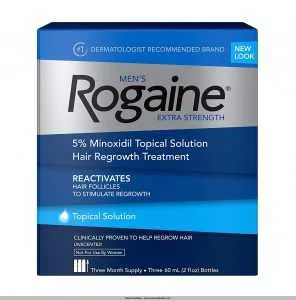
Pioneering hair loss treatment for over 30 years, Men’s Rogaine Extra Strength delivers proven results with its 5% minoxidil solution.
This FDA-approved formula improves hair regrowth by 34% after just 16 weeks.
To use, simply apply 1 milliliter directly to your scalp twice daily and massage it in.
The solution works by reactivating hair follicles and increasing blood flow to combat hereditary hair loss.
For best results, start at the first signs of thinning and use consistently, and purchase from trusted retailers to verify you’re getting the genuine product.
Best For: Men experiencing hereditary hair loss who want a proven solution to regrow and maintain hair with consistent use.
- Requires lifelong, consistent use for hereditary hair loss.
- Potential increased shedding when starting or switching batches.
- Authenticity concerns with some online retailers.
- Clinically proven to improve hair regrowth by 34% in 16 weeks.
- Easy-to-use application that fits into daily routines.
- Safe for color-treated and chemically treated hair.
6. Rogaine Womens 5 Minoxidil Foam Hair Regrowth
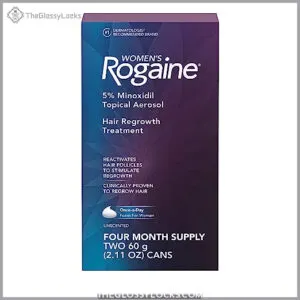
Women’s Rogaine 5% Minoxidil Foam offers a proven solution for female pattern hair loss that men can benefit from too.
This once-daily foam regrows hair up to 48% thicker with its Tricho-Prime technology that conditions your scalp while enhancing absorption.
The unscented formula prevents dryness and keeps follicles open.
You’ll need patience—initial shedding is normal before seeing thicker regrowth after about 4 months.
For best results, apply to dry hair using half a capful and continue daily use to maintain results, and consider pairing with biotin supplements for enhanced effectiveness, using the once-daily foam as directed, to achieve thicker regrowth.
Best For: Women experiencing female pattern hair loss who want a clinically proven, easy-to-use solution for thicker hair regrowth.
- Initial shedding may occur before noticeable regrowth.
- Requires ongoing daily use to maintain results.
- Potential allergy risk with prolonged use.
- Clinically proven to regrow hair up to 48% thicker.
- Easy once-daily application with no mess or strong scent.
- Features Tricho-Prime technology for better absorption and scalp conditioning.
7. Hims Extra Strength Minoxidil Hair Regrowth Foam
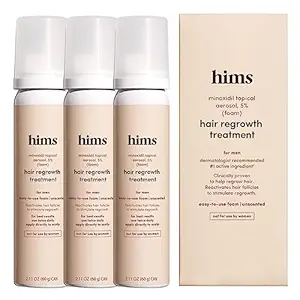
Nearly all men struggling with hair loss can benefit from Hims Extra Strength Minoxidil Hair Regrowth Foam. This FDA-approved 5% minoxidil solution reactivates dormant hair follicles, particularly effective for crown and vertex thinning.
Apply twice daily for best results, with noticeable improvements typically appearing in 3-6 months. You’ll find it’s unscented and easy to incorporate into your routine.
While some users report initial shedding or headaches, most experience thicker hair and reduced fallout after consistent use. No prescription needed, making this doctor-trusted treatment readily accessible for your hair regrowth journey.
Best For: Men experiencing crown and vertex hair thinning who want a clinically proven, FDA-approved daily treatment for regrowth.
- May cause initial shedding or headaches in some users.
- Results depend on consistent use, with regression if stopped.
- Dropper design can be prone to spills and inefficiency.
- Clinically proven to regrow hair in 3-6 months.
- Unscented, easy-to-use foam for twice-daily application.
- No prescription required, with 100% online ordering available.
Lifestyle Changes for Hair Growth
You’ll be surprised how simple daily habits can substantially impact your hair’s health and growth cycle.
Your smoking habits, stress levels, diet choices, and even hairstyling methods all play critical roles in preventing hair loss and promoting regrowth.
Quitting Smoking for Hair Growth
Have you ever wondered how smoking affects your hair health? Quitting smoking is one of the most effective lifestyle changes for preventing hair loss.
Smoking’s hair impact extends beyond your lungs. The effects of smoking on hair follicles are numerous, including:
- Reduces blood circulation to hair follicles
- Increases harmful free radicals damaging follicles
- Contains nicotine’s follicle effect that restricts growth
- Accelerates aging of scalp cells
Offering noticeable cessation hair benefits within 3-6 months of quitting can be a significant motivator for those looking to improve their hair health by quitting smoking.
Reducing Stress for Hair Health
While quitting smoking helps your follicles, managing stress is equally important for your hair’s health.
Excessive stress hormones can push hair follicles into the shedding phase prematurely. Regular meditation benefits include lowering cortisol levels that contribute to stress-induced hair loss.
Improving sleep quality and adding regular exercise impact your body’s stress response positively. A balanced diet supports overall hair health.
This mind-body connection is essential—simple stress reduction techniques might save you from unnecessary shedding, and overall, they contribute to better hair growth and hair health.
Eating a Balanced Diet for Hair Growth
While managing stress helps your hair, what you eat directly affects your follicles too.
Your hair craves specific nutrients to grow strong. Focus on iron-rich foods like spinach and lean meats, along with omega-3 sources such as salmon and walnuts.
Adequate protein intake supports keratin production, while zinc and B vitamins prevent hair loss.
Remember, hair growth vitamins can supplement a balanced diet, but proper hydration remains equally important.
Avoiding Hairstyles That Pull on Hair
While a nutritious diet builds hair from within, your styling choices matter too.
Tight hairstyles like man buns and cornrows can cause traction alopecia, where constant pulling damages follicles.
For hair loss prevention, choose hairstyle alternatives that don’t stress your scalp. Gentle styling with loose cuts helps maintain scalp sensitivity and prevents hair thinning.
If you’re noticing a receding hairline, consider protective styles or hair loss treatments that minimize tension on your follicles, promoting overall hair loss prevention.
Natural Remedies for Hair Regrowth
You’ll find several natural alternatives that can help fight hair loss without harsh chemicals or prescriptions.
Research shows that ingredients like rosemary oil and saw palmetto can stimulate your scalp and block DHT, working similarly to commercial products but with fewer side effects, using natural methods.
Rosemary Oil for Hair Regrowth
While lifestyle changes set the foundation, nature offers powerful solutions too.
Rosemary oil stands out as a scientifically-backed hair regrowth option. A 2015 study showed it works just as well as minoxidil for some men.
You can apply diluted rosemary oil directly to your scalp 2-3 times weekly or add it to your shampoo. Rosemary oil may also improve scalp health with its antiseptic properties.
Most DIY rosemary oil recipes require minimal prep—just be watchful for potential scalp irritation, making it a relatively easy and natural solution.
Saw Palmetto for Hair Growth
If you’re exploring natural remedies, saw palmetto stands out for its DHT-blocking properties.
By inhibiting DHT, a key player in mens hair loss, it supports hair growth with fewer side effects than medications like finasteride.
Clinical evidence shows improved hair density and quality, especially with consistent use of 100-320 mg daily.
Combination therapies often boost results effectively.
Some studies suggest it may block 5-alpha-reductase activity.
Biotin for Hair Loss Prevention
Biotin, a popular hair loss supplement, supports hair health by combating deficiency symptoms like brittle hair.
Found in eggs, nuts, and bananas, it’s a natural hair loss remedy often included in hair growth vitamins.
Recommended biotin dosage varies, but most supplements are safe, and you can explore various biotin hair loss products online.
While efficacy evidence isn’t conclusive, biotin may help prevent hair loss when combined with balanced nutrition.
Onion Juice for Alopecia Areata
Onion juice could make your hair bounce back like never before.
Scientific evidence shows 87% of alopecia areata patients see results in six weeks.
Here’s how:
- Apply twice daily to your scalp for steady regrowth.
- Monitor potential side effects, like an odor—it’s worth the tradeoff!
- Combine with hair growth vitamins for enhanced scalp health.
Frequently Asked Questions (FAQs)
What are the most effective treatments for men’s hair loss?
For men, FDA-approved treatments like minoxidil and finasteride work best.
Minoxidil boosts scalp circulation; finasteride blocks DHT for hair growth.
Combine both for maximum results, but be consistent—it’s a long game, not instant magic.
Can a man’s hair grow back?
Yes, your hair can grow back, but it depends on the cause of the loss.
Treatments like minoxidil, finasteride, or laser therapy boost regrowth.
Consistency and patience are key for noticeable, long-term results.
Can hair grow back after thinning?
Thinning hair can regrow with consistent care.
FDA-approved treatments like minoxidil or finasteride help stimulate growth, while laser therapy and a healthy lifestyle enhance results.
Patience is key—results may take months of commitment.
What is the best treatment for male hair loss?
Combining minoxidil and finasteride is the gold standard for treating male hair loss.
Minoxidil boosts scalp circulation, while finasteride prevents hormone-related thinning.
Stick to daily use, and you’ll likely see improvement within months, making it a treatment worth considering for male hair loss.
What promotes hair loss in men?
Like leaves falling in autumn, hair loss often stems from genetics, hormonal imbalances, or stress.
DHT, a hormone, shrinks hair follicles.
Poor diet, smoking, and harsh styling practices also speed up the process.
What is the best treatment for hair loss in men?
The best hair loss treatments combine FDA-approved options like minoxidil and finasteride.
Minoxidil boosts scalp circulation, while finasteride blocks DHT.
Laser therapy, healthy habits, and natural remedies can enhance results when used consistently together, making finasteride a valuable component.
What is the most effective hair loss product for men?
Picture a shield for your hair: combining minoxidil and finasteride offers proven power, tackling DHT and boosting scalp circulation.
This FDA-approved duo stops hair loss, promotes regrowth, and guarantees lasting results with consistent, daily use, providing lasting results.
What is the best treatment for hair loss?
You’ll get the best results by using FDA-approved options like minoxidil or finasteride.
Together, they slow hair loss and boost growth.
Low-level laser therapy adds an extra kick, while healthy habits support long-term success with finasteride.
What is the best hair loss treatment for men in 2024?
Think of hair loss treatments like a toolbox—minoxidil and finasteride are your power tools.
Combine these FDA-approved options for maximum results, slowing hair loss and promoting regrowth.
Add laser therapy for extra precision and convenience.
Can you actually stop male hair loss?
You can slow or stop male hair loss by combining FDA-approved treatments like minoxidil and finasteride, improving your diet, and reducing stress.
Commitment is key—consistency over several months makes a noticeable difference.
Conclusion
Prevention’s better than cure, especially when you’ve got proven options for hair loss.
The best hair loss treatments for men—Minoxidil, Finasteride, and FDA-cleared devices—offer tangible results when used consistently.
Supplements like Nutrafol and natural remedies like rosemary oil complement these, supporting healthier growth.
Pair treatments with stress management, a balanced diet, and smart styling choices for lasting improvements.
The key is acting early, staying persistent, and tailoring a regimen that works for you.
Your hair deserves it!
- https://www.dermatologytimes.com/view/combining-minoxidil-and-lllt-does-not-improve-treatment-outcomes-for-androgenic-alopecia
- https://wimpoleclinic.com/blog/minoxidil-combined-with-finasteride-an-expert-review/
- https://www.cvs.com/shop/hims-extra-strength-5-minoxidil-foam-for-hair-regrowth-1-month-supply-prodid-428506
- https://www.target.com/p/hims-minoxidil-5-foam-extra-strength-topical-hair-regrowth-solution-for-men-2-11-fl-oz/-/A-83168903
- https://www.kroger.com/p/hims-hair-regrowth-treatment-minoxidil-5-topical-solution-serum/0037173000002

